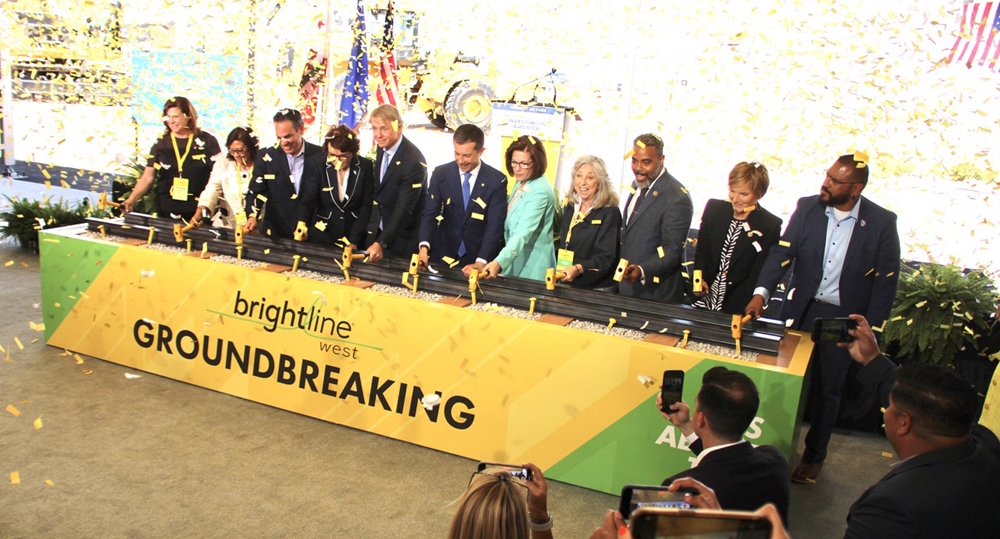
LAS VEGAS, Nev. — The moment for Brightline West has arrived.
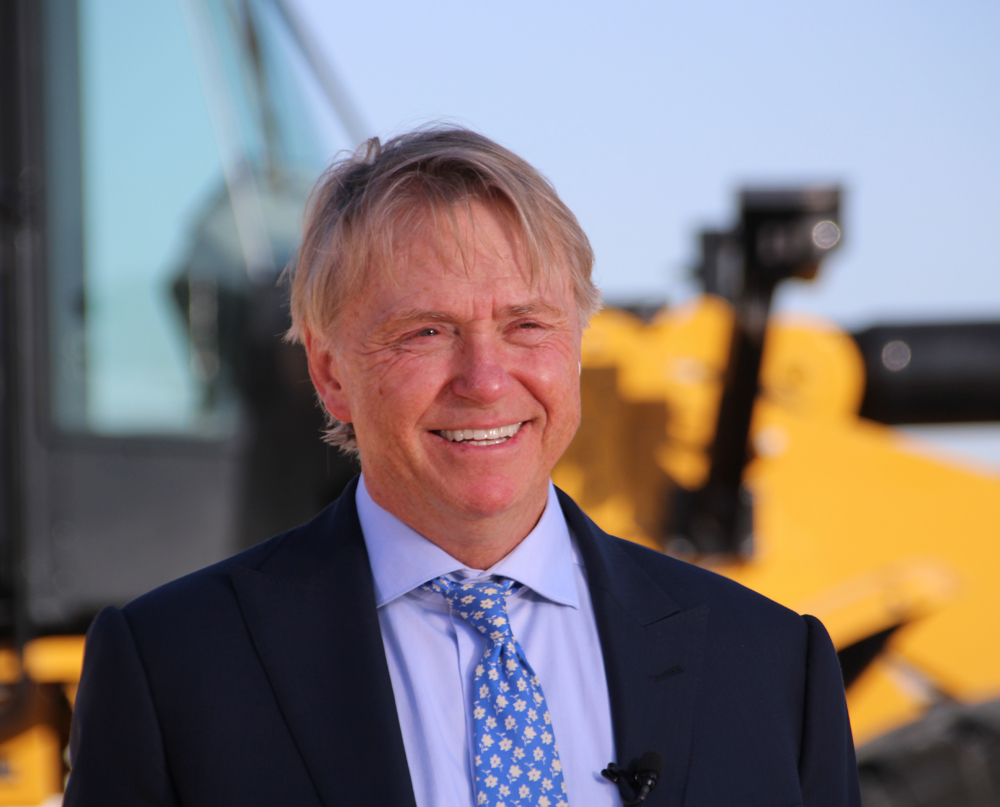
But to Brightline founder Wes Edens — as well as Transportation Secretary Pete Buttigieg and others — a groundbreaking ceremony today on a lot a short distance south of the Las Vegas Strip marked more than just the official start of construction on the 218-mile project to link Las Vegas and Southern California by high-speed train. It was the start of an entire high-speed rail industry in the United States.
“We have an automobile industry,” Edens said. “We have an airplane industry. There’s no reason the United States of America should not be the leader in the world for the high-speed rail industry.”
Edens sees the route between Las Vegas and Rancho Cucamonga as proof of concept for high-speed rail between city pairs that are “too short to fly, too long to drive.
“Our vision is this blueprint is can be repeated all over this country,” he said. “Houston-Dallas, Portland-Seattle, Atlanta-Charlotte — there are many trains that we need to build and will be built as a result of what we’re doing out here right now.”
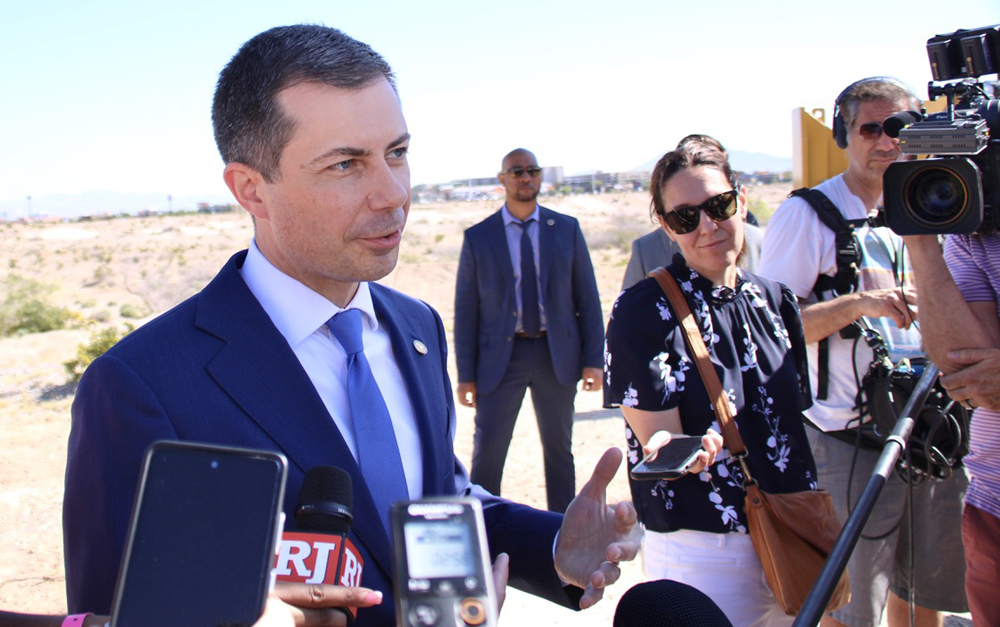
Said Buttigieg, “A few weeks ago, a journalist asked me, ‘Why can’t we have high-speed rail? We want high-speed rail.’ I said, ‘You sound like my boss.’
“But my real answer was we can if we choose to. And now America has decided.”
They were just two of a parade of speakers — also including Nevada Gov. Joe Lombardo, the state’s two U.S. Senators, and five members of the House of Representatives (three from Nevada, two from California) — who heralded the long-awaited start of the project that has, as one said, been discussed in some form since the 1980s.
They saw it not just as a transportation project, though they certainly welcome that aspect (“I have never heard of a stretch of Interstate described as a parking lot more often than I-15,” Buttigieg said), they also pointed to its economic and environmental aspects. Construction is supposed to create 35,000 jobs, the completed line will support 1,000 permanent positions; U.S. Sen. Jacky Rosen said the project is projected to have $10 billion in economic impact in the state. The environmental impact will come from an electrified rail line that takes cars of the road — 800 million pounds of carbon emissions annually, Buttigieg said.
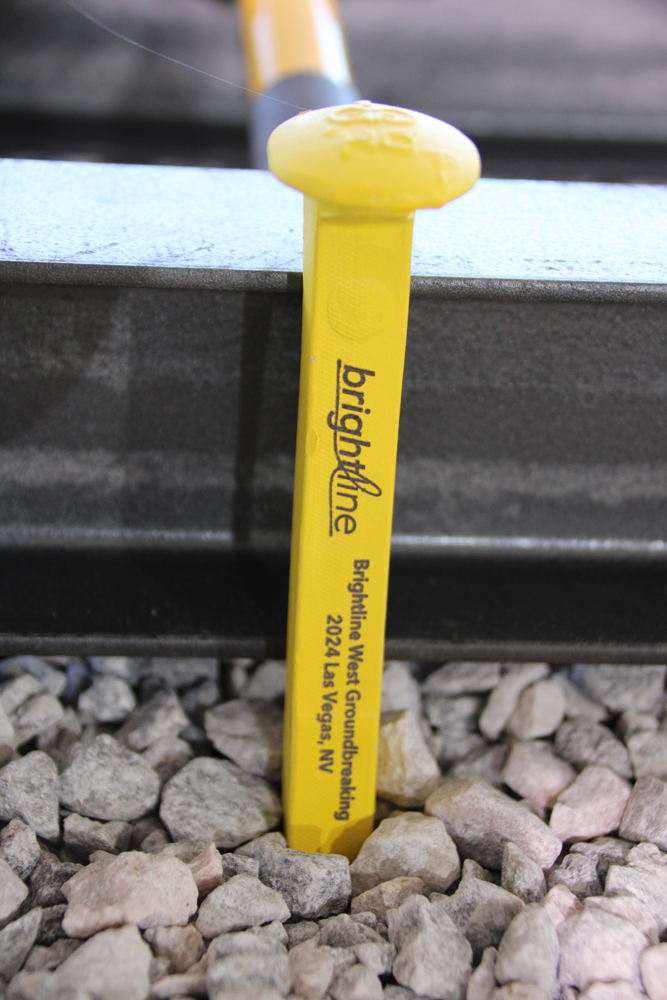
The Monday morning event, on an increasingly scorching day, was both undeniably Vegas in flavor — where else would a groundbreaking include college and professional cheerleaders? — and typically Brightline in both its thorough branding and attention to detail. A vacant lot had been transformed in next to no time (“You should have seen it a week ago,” one person said) with a sturdy tent-like structure, open on one side to provide the Las Vegas skyline as a backdrop for speakers (and TV remote shots). This was not some backyard wedding tent, either, but one big enough to handle the 600 invited guests and media who showed up.
Given the role real estate has played in the original Brightline project in Florida, Edens couldn’t help but comment on the large, barren plot of land adjacent to Las Vegas Boulevard that will be the site of the Las Vegas station.
“I encourage everyone to take lots of photos out there because it’ll be unrecognizable,” he said. “I can pretty much guarantee that everything will be built on. There will be all kinds of communities, private apartments, offices, casinos, a lot of different things.”
First, of course, there will be a rail line. The company has laid down the ambitious goal of having it running in time for the 2028 Olympic Games in Los Angeles, which are set to open that July 14. When the officials hammered those Brightline yellow spikes into the gravel to mark groundbreaking, the countdown clock for the Games was at 1,550 days.
California has a reputation as being a notoriously difficult place to build major projects, but Edens told Trains News Wire he’s confident about that process.
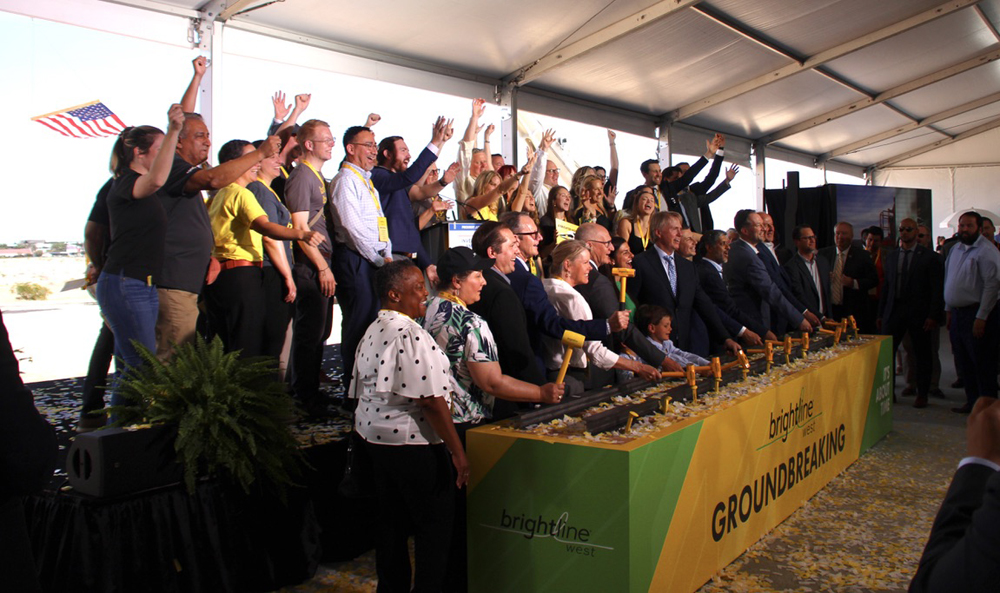
“We’ve gotten massive cooperation from both Nevada and California on the right-of-way,” he said. We have construction permits in the right of way. We expect it to be no different in California than here, not at all. Actually, the heavy lift has already been done in terms of all the environmental and the permitting and all those processes. That stuff has taken years. We feel like that’s behind us now. It’s just a matter of literally putting shovels in the ground and building it.”
Among the many tasks that will need to be addressed soon to meet that four-year deadline: ordering of equipment. The initial Brightline West operating model, as laid out in the environmental report for the Victor Valley-Rancho Cucamonga segment, calls for 23 trains a day each way, operating on 45-minute headways. Tom Rutkowski, Brightline vice president and chief mechanical officer, says the company estimates it will need 10 trainsets to begin operations. Given the lead time for construction, that would indicate that the need to order equipment to have it ready in time would be fast approaching; Rutkowski said he could not speak to specifics but that “we are literally in the final stages of the decision … we are close.”
— Updated April 24 at 10 a.m. to correct carbon emissions figure to 800 million pounds.














I no longer live in Southern California but did for 60 years. I also no longer have any desire to visit Las Vegas, except prehaps as a place to fly into and rent a car to go to Ely for the Nevada Northern.
That said:
One thing they got right is planning 23 trains a day on 45 minute headways. That at least gives some hope of getting on the train if as is often the case, it takes 2 hours to get to Rancho Cucamunga instead of the 30 minutes. As far as I can tell the 4-5 million folks within 30 minutes are only within 30 minutes between the hours of 10 PM and 6AM.
I wonder if a stop at Primm would make sense.
All of this begs the question of how good the transportation will be from the station to casinos and other destinations in Las Vegas. Too bad the monorail there was such a mess. But there is still that other thing, about driving your own car….you get to use it when you get to your destination. That’s a high bar to overcome when you are going to a location where folks often want move around once there. Oh, sure taxis, but if you just lost a wad in the casino, you might think twice about that option.
To date Brightline West has raised $3 billion of the $12 billion they say they need for this line.
They can issue $3.5B in govt activity bonds but those haven’t been sold yet. And as we saw in the past with Brightline West and Brightline, the private investors are not enamored with passenger rail.
There’s a bad chance that Edens is pushing forward with this project now knowing he’ll never get from the private capital markets what he needs. But with the olympics coming up and Biden in office, he’s rolling the dice that the public will make up the other $5 – 9 billion he needs to raise.
If that’s the case, don’t be surprised in a few years to see articles about this project being mothballed.
I still don’t get this project. It means yet another rail line through Cajon Pass. That’s not like building a rail line (or freeway) through a wide-open desert.
If much/ most of the r/w is in the median of I-5, that’s a whole lot of I-5 being rebuilt. I have never heard of a highway reconstruction project a fraction of that length.
I have to wonder how much of the rebuilding of I-5 to accommodate the railroad will be a hidden cross-subsidy from the highway construction budgets in each of the two states.
This project makes no more sense to me that does California’s other HSR project, which is a proven fiasco.
I meant I-15. Sorry.
For much of the route, the north and southbound lanes of I-15 are widely separated; in addition, the right-of-way controlled by CalTrans is wider than the existing infrastructure. While the various environmental documents I’ve reviewed don’t always paint the same picture about what’s staying and what’s being replaced, this isn’t as daunting of an engineering task as it might seem – and pales in comparison to the CHSR effort. And no, I don’t think CalTrans is gaining anything in highway terms through creative accounting. There might be some benefits for I-15 motorists in climate change resilience terms though (think normally dry washes that are under-engineered for high water events as our precipitation becomes even more boom-and-bust than was the case in the 20th century).
“If much/ most of the r/w is in the median of I-5, that’s a whole lot of I-5 being rebuilt. I have never heard of a highway reconstruction project a fraction of that length.”
In 2008 the NM Rail Runner was extended to Santa Fe including just under 13 miles in the median of I-25. That project included new bridges over existing roads and highways, a cut and fill box culvert under I-25 northbound lanes entering the median, a cut and fill box culvert under southbound lanes leaving the median, and a passenger station in the median at the NM 599 interchange south of Santa Fe. Other than that listed above, not a whole lot of the I-25 roadway was impacted except lane closures during actual median construction.
Will only take 4 years for construction of the rail line and trains will be running by mid 2028? Hard to believe.
There is probably more like 5 million people within 30 minutes of Rancho Cucamonga. The way the Inland Empire, as this area is informally known, has grown the past many years is astounding. I would much rather drive to Rancho Cucamonga and take a high speed train to Las Vegas than drive I-15. I-15 even on a good day is a mess, and there are not a lot of good days out on I-15.
I think most people who dismiss the Rancho Cucamonga station don’t seem to realize that there is roughly 3-4 million people within a 30 minute travel radius of that station. LA will follow but you must remember that the 4-5 hours driving from the IE and Orange County is likely (in good conditions) 5-6 hours from the westside of LA…I think many of them will gladly skip that long drive to park in RC and take this train.
It’s already a long drive from LA or Orange COunty to Rancho Cucamonga. They’ve already got their stuff packed and in the car. Why stop at Rancho instead of just keep driving?
The station isnt’ being dismissed, it’s the whole darn Brightline West business plan that’s questionable.
One point about the trip on Brightline West: how many stops will there be between Cucamonga and Las Vegas? How many cities will sue in order to get stops in their city? If there are no stops in Victorville (CA), Barstow (CA), Baker (CA) or Primm (NV), I can see each one of those cities suing to get stops in their cities. This will only add to the time.
There are environmentalist groups here in California who will more then likely sue, claiming environmental damage, and even suing to reduce the speed of the trains because of “climate change”. Then there will be some animal rights groups suing because of some “endangered” animal or insect they claim is in the path of the route.
As litigious as this state (CA) can be, none of that would surprise me. It will add a ridiculous amount of $$$$ to the cost for Brightline, and delay construction for years.
The environmental studies have been done and most permits are already in hand. The route is entirely within the median of I-15 (except for a short distance from I-15 to Rancho Cucamonga). CA and NV DOT’s are in favor as the construction will require some lane modifications, bridge and other improvements which otherwise would be paid by the tax payers. Power will be electric overhead catenary from renewable energy locations in Nevada (that will need to be supplemented in the future as CA is requiring electric for everything). For the past four months the company has been performing geotechnical work along the highway to allow final design. The time frame (July 2028) is extremely optimistic but they are looking at throwing over 10,000 construction workers at building it.
Their passenger base is more from the LA area than from LV to LA. Rancho Cucamonga is a more centralized location to have it initially begin. A later phase would be extending it to downtown LA. Other stations are at Hesperia (for commuters) and Apple Valley.
Anton do you really think these towns are going to sue a private company and demand a station. The more real outcome would be they approach Brightline with their idea and then work together with available tax funds to support a station. I see no benefit in suing Brightline for years in court when there are other ways, especially if Brightline sees an opportunity to build a station/retail complex that will generate more profit for Brightline like some areas in Florida.
My comment above said over 10,000 construction jobs to build it. The press release said 35,000 construction jobs!! They will be paying union wages and will likely draw workers from all over the west if not the country. Anyone that has an RV park along the route needs to be ready for that influx.
Doesn’t CalHSR have a construction worker shortage? They pay union scale as well.
Cucamonga is an hour from most of LA when there is light traffic (rarely). Plus no secured parking. When you get to Vegas, where is the transit to the various casinos? Still more convenient to drive.
If 300 or so people are getting off trains in Vegas, the casinos will have transport waiting at the station.
This is not the Amtrak model where those things are after thoughts if at all. If someone is driving from that area to LV it will take 4-5 hours or longer minimum so some will fly. It’s a short flight in the air but you have travel to the airport, check-in, security, etc. and still need transportation once you get to LV. The train will cut driving time in half, avoid traffic hassles and allow relaxation with books or wifi. There is at least one YouTube video that presents the route and likely speeds, and discusses work necessary to complete it. Search “The Brightline West HSR Route Rendered With Unreal Engine 5” for a very realistic 25-minute overview of the project work that is necessary.